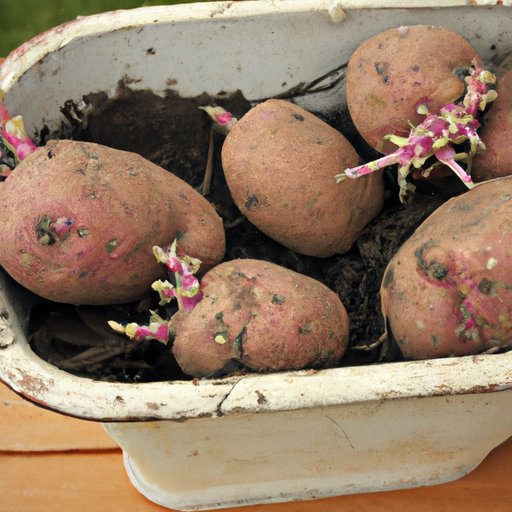
I. Introduction
Planting potatoes is a fun and rewarding activity that can provide a fresh, homegrown crop for your family’s meals. Whether you’re an experienced gardener or just starting out, this comprehensive guide will provide you with all the necessary information and tips to successfully plant, grow and harvest potatoes at home.
II. A Step-By-Step Guide to Potato Planting
Before you start planting, make sure you have all the necessary tools and materials. You will need seed potatoes, a garden fork or spade, trowel or hoe, compost, and mulch.
The first step in potato planting is preparing the soil. Ensure that the soil is well-drained and loose as potatoes grow best in fertile, loose soil. Use a garden fork or spade to till the soil to a depth of 10 to 12 inches. Remove any rocks, roots or debris you may come across as these interfere with the growth of potatoes.
In selecting seed potatoes, it is essential to choose ones that have not been chemically treated to prevent sprouting and diseases. Cut larger seed potatoes into smaller pieces that contain two to three eyes each. Allow them to cure for a few days to promote healing of the cut surfaces before planting.
When planting potatoes, choose a spot with plenty of sun exposure. Dig a planting hole for each seed potato about seven to eight inches deep and 12 to 15 inches apart. Place the seed potato in the hole with the cut side facing down and the eye facing up. Cover with soil and water using a watering can or a gentle spray. After the soil has settled a bit, add a layer of mulch on top.
Continue watering consistently and mildly keeping the soil moist until the first buds appear in approximately 2-3 weeks. After that, maintain a moderate moisture level so as not to overly wet the soil.
III. A Beginner’s Guide to Potato Planting
There are several types of potatoes to choose from, and each type requires different growing requirements. It is important to select the right type of potato and prepare the soil correctly to ensure a healthy and thriving crop.
Before planting, it is crucial to ensure that the soil is nutrient-rich and adequately fertilized. Add aged manure or compost to the soil to enhance its fertility.
Beginner gardeners may make common mistakes such as planting seed potatoes too deeply or over-fertilizing without taking into account the soil’s nutrient content. It is essential to choose the right type of potato and prepare the soil correctly, taking into account the soil nutrient level and the potato variety you intend to plant to avoid these mistakes.
IV. A Seasonal Guide to Potato Planting
The best time to plant potatoes varies depending on the area and climate. In general, it is ideal to plant potatoes when soil temperatures reach approximately 50-55F and air temperatures are around 60-70F.
The potato planting season usually begins in spring, typically mid-April or May, depending on the region. In cooler climates, it’s good to wait until the soil has reached the ideal temperature before planting the seed potatoes. In warmer areas, planting can also be done during the fall with some adjustments made for the cooler weather.
V. An Organic Approach to Potato Planting
For gardeners who prefer natural methods, there are numerous organic options available for planting and caring for potatoes. Companion planting, natural pest control, and soil regeneration are excellent ways to promote healthy potato growth.
Companion plants such as beans, peas, and other legumes help fix nitrogen into the soil—a vital nutrient for potatoes. Natural pest control measures like handpicking pests, using sticky traps, and planting marigolds around the potato plants keep pests away without using synthetic chemicals. Soil regeneration techniques like crop rotation and cover cropping help to promote soil health and reduce soil-borne diseases.
VI. A Container Gardening Guide to Potato Planting
Growing potatoes in containers is an excellent alternative for gardeners with limited outdoor space or unfavorable soil conditions. Potatoes thrive in deep containers that allow easy root growth and prevent excessive watering.
The best containers for potato planting are grow bags or large plastic containers with drainage holes at the bottom. Add lightweight soil that contains a balanced mix of nutrients, and make sure that there’s enough room for your seed potatoes to grow comfortably. It is important to select the right variety of potatoes for container gardening, ideally those classified as “determinate” varieties that don’t require too much vertical space.
VII. A Troubleshooting Guide for Potato Planting
Some of the most common problems encountered with potato planting include fungal diseases such as blight, pests such as potato beetles, and soil-borne diseases such as scab.
One of the most effective ways to prevent diseases is by planting disease-resistant potato varieties. Some organic solutions to pest control include using natural insecticides such as diatomaceous earth, handpicking pests from the plants, or using sticky traps. Enhancing the soil fertility level is one way to manage scab diseases or even avoid them altogether, especially when scab is caused by mild acidity.
VIII. Conclusion
Planting potatoes is an exciting and fulfilling experience that can provide many months of fresh, home-grown produce. With the information provided in this guide, beginners and experienced gardeners alike can take their first steps towards planting and maintaining a healthy potato crop. Remember to choose the right type of potato, prepare the soil correctly, and take adequate measures to prevent diseases and pests for the best results.
So grab your gardening tools, head outside, and try planting potatoes today.




